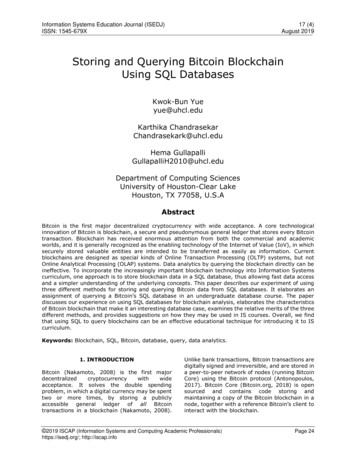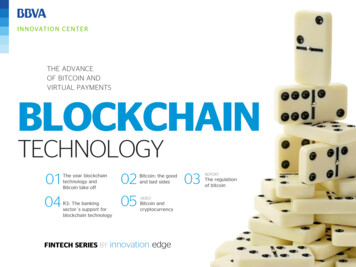
Transcription
Bitcoini
BitcoinAbout the TutorialThe tutorial begins by introducing what bitcoins are, then proceeds with the installation ofthe bitcoin client software and wallets to make bitcoins transactions possible. It alsodiscusses bitcoin mining, exchanges, and trading. Finally, it moves on to applications andfuture of bitcoins. After reading this tutorial, you will have learned all the basics of bitcoins;enough to use bitcoins and make money by trading and investing in bitcoins.AudienceThis tutorial has been prepared for professionals aspiring to learn all the essentials ofBitcoins and develop a habit of buying products and services using bitcoins and lastlymaking money by trading in this brand new cryptocurrency.PrerequisitesBefore you start proceeding with this tutorial, we assume that you have basic computerskills, knowledge of downloading and installing software like Java and other applications.Prior exposure to the Linux operating system flavors would be an added advantage.Copyright & Disclaimer Copyright 2019 by Tutorials Point (I) Pvt. Ltd.All the content and graphics published in this e-book are the property of Tutorials Point (I)Pvt. Ltd. The user of this e-book is prohibited to reuse, retain, copy, distribute or republishany contents or a part of contents of this e-book in any manner without written consentof the publisher.We strive to update the contents of our website and tutorials as timely and as precisely aspossible, however, the contents may contain inaccuracies or errors. Tutorials Point (I) Pvt.Ltd. provides no guarantee regarding the accuracy, timeliness or completeness of ourwebsite or its contents including this tutorial. If you discover any errors on our website orin this tutorial, please notify us at contact@tutorialspoint.com.ii
BitcoinTable of ContentsAbout the Tutorial . iiAudience . iiPrerequisites . iiCopyright & Disclaimer . iiTable of Contents . iii1.Bitcoin ― Introduction . 1How to use Bitcoins? . 1How does Bitcoin handle double spending problem? . 1History of Bitcoins . 2Bitcoin Transactions . 3How does Bitcoin have value? . 32.Bitcoin ― Environmental Setup . 5What is a Bitcoin full node? . 5Java Installation . 53.Bitcoin — Blockchain Technology . 7What is a blockchain? . 7Advantages of Blockchain Technology . 84.Bitcoin — Cryptocurrencies . 9Pros and Cons of Cryptocurrencies . 95.Bitcoin ― Features . 10Features of bitcoins . 10Drawbacks of bitcoins . 106.Bitcoin — How do they work? . 12How do bitcoin transactions work? . 12How to send bitcoins? . 137.Bitcoin — Wallet . 15What are public and private keys? . 15iii
BitcoinTypes of Bitcoin Wallets . 15Opening a Bitcoin Wallet Account . 178.Bitcoin ― Mining . 19Proof of work . 19BitMinter . 20Using BitMinter for Mining . 209.Bitcoin — Exchanges . 22Exchanges of Bitcoin . 2210. Bitcoin ― Trading . 23Arbitrage in bitcoins . 23Margin trading in bitcoins . 23Trading in bitcoins . 23Coinbase and trading . 2311. Bitcoin ― Glossary . 2512. Bitcoin — Applications . 3113. Bitcoin ― Future . 32Favoring Growth Factors . 32iv
1. Bitcoin ― IntroductionBitcoinBitcoin emerged out of the 2008 global economic crisis when big banks were caughtmisusing borrowers’ money, manipulating the system, and charging exorbitant fees. Toaddress such issues, Bitcoin creators wanted to put the owners of bitcoins in-charge of thetransactions, eliminate the middleman, cut high interest rates and transaction fees, andmake transactions transparent. They created a distributed network system, where peoplecould control their funds in a transparent way.Bitcoin has grown rapidly and spread far in a relatively short period of time. Across theworld, companies from a large jewelry chain in the US, to a private hospital inPoland, accept bitcoin currency. Multi-billion dollar corporations such as Dell, PayPal,Microsoft, Expedia, etc., are dealing in bitcoins. Websites promote bitcoins, magazines arepublishing bitcoin news, and forums are discussing cryptocurrencies and trading inbitcoins. Bitcoin has its own Application Programming Interface (API), price index, tradingexchanges and exchange rate.However, there are issues with bitcoins such as hackers breaking into accounts, highvolatility of bitcoins, and long transaction delays. Elsewhere, particularly people in thirdworld countries find Bitcoins as a reliable channel for transacting money bypassing peskyintermediaries.How to use Bitcoins?We can make bitcoin transactions as we do with our familiar fiat currencies. While we useBitcoin, the purchaser is actually referenced to our digital signature, which is a securitycode encrypted with sixteen different symbols. The purchaser decrypts the code with hisdevice to get the cryptocurrency. Therefore we can say that cryptocurrency is an exchangeof digital information that permits us to buy or sell goods and services.The transaction is secured and made trustworthy by running it on a peer-to-peer networkthat is akin to a file-sharing system.How does Bitcoin handle double spending problem?For digital cash system, a payment network necessarily should have valid accounts,balances and transaction records. The biggest bottleneck common to every paymentnetwork is the double spending problem which is the case when same money is usedmultiple times to do transactions.To prevent double spending, all transactions have to be recorded and validated every timein a central server where all the balance records are kept. However, in a decentralizednetwork, every node on the network has to do the job of a server; it has to maintain listof transactions and balance records. Thus, it is compulsory for all nodes/entities in thenetwork to keep a consensus about all these records. This was achieved by using theblockchain technology in bitcoins.So we can say that bitcoins like other cryptocurrencies are mere token entries stored inthe decentralized databases that keep consensus of all balance and account records. It is1
Bitcointo be noted that cryptography is used extensively to secure the consensus records. Bitcoinsand other cryptocurrencies are secured by math and logic more than anything else.Bitcoins and cyptocurrencies have gained recognition and adoption based on theirperceived value by their creators and users.Bitcoin works on the same concept, the more people participate; the more value iscreated.History of BitcoinsThe first Bitcoin protocol and proof of concept was published in a Whitepaper in 2009 bya shadowy individual or group under the pseudonym Satoshi Nakamoto. EventuallyNakamoto, who remained mysterious, left the project in late 2010. Other developers tookover and the Bitcoin community has since grown exponentially.While Satoshi Nakamoto’s real identity remains shrouded in mystery, it is on record thathe communicated extensively in Bitcoin’s early days. Let us speculate on questions likewhen he started working on Bitcoin, to what extent he was inspired by similar ideas andwhat was the motivation for bitcoin.Creation of the first bitcoin domainIt is believed that Satoshi started coding Bitcoin around May 2007. He is said to haveregistered the domain bitcoin.org in August 2008. Around that time, he started sendingemails to a few individuals he thought might be interested in the idea of bitcoins.In October 2008, he publicly published a white paper that dwelt on the Bitcoin protocol,and released the Bitcoin code as well. Then he stayed in contact for about two years,during which he interacted actively in forums, communicated with several developers andlater he also submitted patches to the initial code. He maintained the source code alongwith other developers, tackling issues as they happened. By December 2010, as othershad slowly taken over, he quietly left the scene.EntitiesThe entities involved in the implementation and maintenance of Bitcoins are: The Blockchain platform Cryptographic algorithms Bitcoin miners which are computers or specialized machines that mint the currencyand make possible transactions People who participate in the transactions and thus help to move the paymentsystemThe philosophy of Bitcoin, and in general, of all cryptocurrencies is that they are distributedsystems where there is no central entity that manages the activities such as transactions,among others. It is a peer-to-peer (p2p) system that operates at the level of participants.2
BitcoinBitcoin TransactionsWe shall now see how a new block of bitcoin transaction is created.A bitcoin miner creates a block by using the following steps: Gathering pending transactions, preferentially those with transaction fees first, andthen the free ones Verifying the transactions for their validity Solving a hashing problemAccording to the statistics, in October, 2015, blockchain.info site stated that, the averagenumber of transactions per block was 411, and as of May 2018, the current number ofpending unconfirmed transactions is around 2495.Reward and cost per bitcoin transactionAssuming that one bitcoin is worth 400, the reward of 25 bitcoins per block is wortharound 10,000, ignoring negligible amount of transaction fees. Taking average numberof transactions per second as 2, and the number of transactions per block as 1200, thereward per transaction works out to 8.33. It is found that the cost of electricity consumedin mining is close to the reward which makes mining bitcoins not so profitable. The basicproblem of mining as of now, is the 1 MB limit on block size which makes it possible tohave at most only 10 transactions per second.Confirmation of a bitcoin transactionA transaction is considered to have received n confirmations if it has been published in ablock in the block chain, and n-1 more blocks have also been added. A transaction isnormally considered “confirmed” once it has six confirmations. Newly created Bitcoins areconsidered confirmed after they have received about a hundred confirmations.How does Bitcoin have value?It is the common consensus, belief and the perception that gives value to the bitcoin. Allthe participants in this system have consensus on the following: immutability and integrity of the blockchain security and validity of the payments rules of the systemBitcoin was the first practical implementation of blockchain technology and is currently themost significant triple entry bookkeeping system globally. In a bitcoin ecosystem, accessto entire source code is available to everyone always and any one can review or modifythe code. The authenticity of each transaction is secured by digital signatures of thesending parties thus ensuring that all users have complete control over sending bitcoins.Thus, leaving a little room for fraud, no chargebacks and no identifying information thatcould be hacked resulting in identity theft.Here is a list of some of the entities who accept Bitcoins: Wordpress3
Bitcoin Namecheap Microsoft Dell Computers Archive.org Bitpay Bitspend.net4
2. Bitcoin ― Environmental SetupBitcoinSatoshi Nakamoto released the first bitcoin software as open source code in January 2009.He later renamed it to "Bitcoin Core" to differentiate it from Bitcoin network.Bitcoin Core is a bitcoin implementation. It is a full Bitcoin client and is backbone of thenetwork which provides high levels of security, stability, and privacy. It also assistsnetwork in relaying transactions. It requires at least 50 GB of hard disk space and is notrecommended for new Bitcoin users who can opt for lightweight mobile or desktop wallets.What is a Bitcoin full node?A full node is a software program that fully validates transactions and blocks. Most fullnodes also assist the network by accepting and validating transactions and blocks fromother full nodes, and then relaying them further to other full nodes.Bitcoin Core full nodes need to have certain requirements. If a node is run on weakhardware, it may work — but with a host of issues. It will be an easy-to-use node, if thefollowing requirements are met: Desktop or laptop hardware running latest versions of Windows, Mac OS X, or Linux About 150 Gb of free disk space, accessible at a minimum speed of 100 MB/s 2 GB of RAM memory A broadband internet connection with upload speed of at least 50 kilobytes persecond Preferably, an unmetered connection, a connection with high upload limits. It iscommon for full nodes on high-speed connections to use 200 GB upload or more amonth. Download usage is around 20 GB a month, plus an additional 150 GB thefirst time you start your node 6 hours a day of full node runningBitcoin Core can be downloaded from the site https://bitcoin.org.Apart from downloading bitcoin client, we have to set up several accounts. Going furtherin this tutorial, we will learn how to open accounts in bitcoin sites and to create accountsin bitcoin wallets, bitcoin exchanges, bitcoin mining sites, faucet sites, and sites that offerbitcoin tools and value added services.Java InstallationTo run a mining software like BitMinter client, we need to have latest compatible versionof Java installed. BitMinter client can be downloaded from https://bitminter.com.To install Java, you can follow these steps: Go to www.java.com/download.5
Bitcoin Click on the button "Free Java Download". Click on "Agree and Start Free Download" button. Select the version that is compatible with your operating system. Follow the onscreen instructions to continue installing the software. Once the installation is completed, click on Finish button. Continue on to the next step to set up a miner.6
3. Bitcoin — Blockchain TechnologyBitcoinIt is believed that Blockchain is a new age technology that is solution waiting for a hostof problems. There is no doubt that it is a new wonder in the field of computing.What is a blockchain?A blockchain is basically a perpetually growing list of records, called blocks. These blocksare linked and secured by using cryptography. Each block generally contains acryptographic hash of the previous block along with timestamp and transaction data. Byits design, a blockchain does not allow modification of the data.It is an open, distributed ledger that records transactions between different partiesefficiently and in a verifiable and permanent way. A blockchain, as shown in figure belowis typically managed by a p2p or peer-to-peer network collectively following a protocol forcommunication between nodes and for validating new blocks. Once recorded, the data inany given block cannot be altered without consensus of the network majority.In case of bitcoins, the blockchain is a public ledger that records bitcoin transactions. It isimplemented as a chain of blocks. Each block contains a hash of the previous block upto the genesis block which is the first block of the bitcoin blockchain. This is howeverachieved without any trusted central authority: the working of the blockchain is performedby a network of communicating nodes running bitcoin software. Transactions of the typepayer A sends B bitcoins to payee C are broadcast to this network using existing softwareapplications.Nodes in the network validate new transactions, add them to their copy of the ledger, andthen convey these ledger additions to other nodes. Each network node stores its own copyof the blockchain. Roughly every 10 minutes, a new group of validated transactions, a7
Bitcoinblock, is created, and added to the blockchain, and then quickly published to all networknodes. This makes it possible for bitcoin software to determine when a particular bitcoinamount has been spent, and this prevents double-spending in a decentralizedenvironment. It is noted that the blockchain is the only place where bitcoins can be saidto exist in the unspent form.Blockchain technology has led to the development of new, digital currencies like Bitcoinand Litecoin that are not issued or managed by government or any central bank of acountry. This frees individuals from any kind of control and intermediaries like bankingsystems that are scam and subject to collapses. It has also led to distributed computingtechnologies like Ethereum, which has introduced smart contracts.Blockchain is a replicated, shared ledger technology that allows any participant in thenetwork to see ledger and make changes. It is open source, bringing down costs,improving efficiencies, increasing accessibility, addressing exciting and topical businesschallenges across a broad spectrum. Linux Foundation’s Hyperledger is a projectdeveloping an open source, open standards shared ledger technology.Nowadays, consumers demand transparency regarding products and their making.Governments require more information about corporate supply chains, with penalties fornon-compliance. In such scenario, blockchain technology promises to deliver suchexpectations. It enables secure digital transfer of value or property across supply chains.Advantages of Blockchain TechnologyThe following are the advantages of Blockchain Technology: Transactions are now verifiable, disallowing any party from making changes Greater efficiencies are being achieved through greater transparency Consumers have been empowered to make informed purchases Now governments are able to procure reliable information.Many experts believe that blockchain technology can be used in online voting,crowdfunding and other emerging technologies and novel ideas. Major financial institutionssuch as JP Morgan Chase are confident that cryptocurrencies can lower transaction costsand make payment processing more efficient.Bitcoin is one of the most popular and successful implementations of blockchaintechnology. It is an open source cryptocurrency that uses distributed peer-to-peercomputing. There is no need of a central authority to manage bitcoin network. It wascreated by a person or group under the pseudonym of Satoshi Nakamoto. Thetransactions on this network are verified by proof-of-work algorithms on computersrunning a mining software.8
4. Bitcoin — CryptocurrenciesBitcoinCryptocurrency is digital currency that uses cryptography to secure its transactions. It isdifficult to make counterfeit crypto currency because of this security feature. A remarkablefeature of any cryptocurrency, is the fact that it is not issued by any central bank orgovernment authority, making it immune to any government manipulation.There are over 17 million bitcoins in circulation as of May 2018, with a total marketcapitalization of over 140 billion. Bitcoin's success has given rise to a number of similarcryptocurrencies called altcoins: Namecoin, Litecoin, PPCoin, etc.Pros and Cons of CryptocurrenciesCryptocurrencies make it possible to transfer funds between parties and these transfersare effected through the use of public and private keys as a means of security. These fundtransfers are carried out with nominal or zero processing fees, allowing users to avoid theexorbitant fees charged by most banks and other financial intermediaries for the transfers.Apart from the fact that prices of cryptocurrencies are based on supply and demand, ithas been found that the exchange rates of cryptocurrency fluctuate widely due to a hostof reasons.The anonymous feature of cryptocurrency transactions renders them vulnerable to illegaltransactions, such as money laundering, drug and weapons dealing, terror funding andtax evasion by criminals. However, anonymity of transactions has its own host of pluspoints. Cryptocurrencies are also considered by some economists to be a passingphenomenon or a speculative bubble that can burst any moment because of their virtualor digital nature. Bitcoin has indeed seen some exponential surges and sudden collapsesin value.Cryptocurrencies are also not totally secure from hacking. In Bitcoin's short life-span, thecurrency has been subject to over 40 hackings, including few that topped 1 million invalue. Still, many see cryptocurrencies with hope as a medium of exchange that preservesvalue, facilitates easy exchange, is more liquid and portable than bullion, and is outsidethe purview of central banks and governments.Through many of their unique properties, cryptocurrencies allow exciting applications thatcould not be provided by any traditional payment systems.There is no physical cryptocurrency, but balances are secured with public and private keys.These balances are maintained on public ledgers, along with all transactions, that areverified by a huge amount of computing power.In early 2014, the Inland Revenue Service of the US declared that all crypto-currencies,including Bitcoin, would be taxed as property rather than currency. It was stated that allgains or losses from such currencies held as capital will be treated as capital gains orlosses, while those held as inventory will attract ordinary gains or losses.9
5. Bitcoin ― FeaturesBitcoinWe have seen that bitcoins are becoming more and more popular and their usage isincreasing at accelerated pace geographically. We will understand this process if we studydifferent useful features of bitcoin that make them what they are.Features of bitcoinsOne of the most direct benefits of Bitcoins is that they are out of purview of governments,banks and other intermediaries who cannot interrupt user transactions or freeze Bitcoinaccounts. The users experience greater freedom vis-à-vis dealing in national currencies.There cannot be inflation in case of bitcoins by printing more money as in the case of fiatcurrencies. By design, the number of bitcoins that can be minted is limited.Since there is no way to identify, track or intercept bitcoin transactions, one of the majoradvantages of bitcoin usage is that taxes are not added onto any purchases.Bitcoin transactions are relatively faster as compared to bank transfers in traditionalcurrencies. Bitcoin transactions are done with nominal or sometimes zero transactioncharges. These transactions are anonymous with no names involved. Every transaction isa public record which anyone can see. Your private key is the only link between you andyour bitcoins. As long as the private key is secure, your money is safe. It is very easy tosend and receive bitcoins because of ease of operation of bitcoin accounts.Small amounts of bitcoin that are used as alternative units are: millibitcoin (1 mBTC 0.001 BTC), and satoshi (1 sat 0.000001 BTC) which is a millionth of a biticoinin value.You can use different wallets and tools for transacting in bitcoins.Drawbacks of bitcoinsLet us examine the cons or drawbacks of bitcoins. These limitations of bitcoins make themless attractive and makes us seek better options. We have to somehow overcome oreliminate these limitations of bitcoins to make them user friendly. Bitcoins are a new emerging currency whose work is still in progress. Their value is highly volatile and unstable seeing wild fluctuations. It is internet-based, without which it cannot function. It is totally virtual currency and money can be lost due to computer breakdown orthe absence or failure of a backup. Losing your private key can result in losing your bitcoins. There is no way that the transactions can be reversed or cancelled once completed. There can be misuse of anonymity of bitcoin transactions for criminal activities. The benefits of bitcoins are skewed highly in favor of early adopters.10
Bitcoin Bitcoin can be replaced with a better similar product and there is uncertaintyregarding its continuation over a long period of time. Governments can ban bitcoins and make transactions in bitcoins difficult. The slowness of transaction verification is also an issue. The current version of bitcoins is not fit to handle very high volume of transactions.11
6. Bitcoin — How do they work?BitcoinThe process of creating or minting bitcoins is difficult to hack and this gives security tobitcoins. Another layer of security is the provision that every transaction has to be verifiedbefore being validated. This verification is effected through "mining". Mining is a processwhere some high-level computing like SHA256 decoding is done to verify transfers ofbitcoins.Bitcoins are stored in a “digital wallet”, which exists either on a user’s computer or on thecloud. The wallet is a type of virtual bank account that facilitates users to send or receivebitcoins, pay for goods and services or save their money.How do bitcoin transactions work?Every bitcoin account consists of a public key which works like a bitcoin address and aprivate key. Anyone can
publishing bitcoin news, and forums are discussing cryptocurrencies and trading in bitcoins. Bitcoin has its own Application Programming Interface (API), price index, trading exchanges and exchange rate. However, there are issues with bitcoins such as hackers breaking into accounts, high volatility of bitcoins, and long transaction delays.










